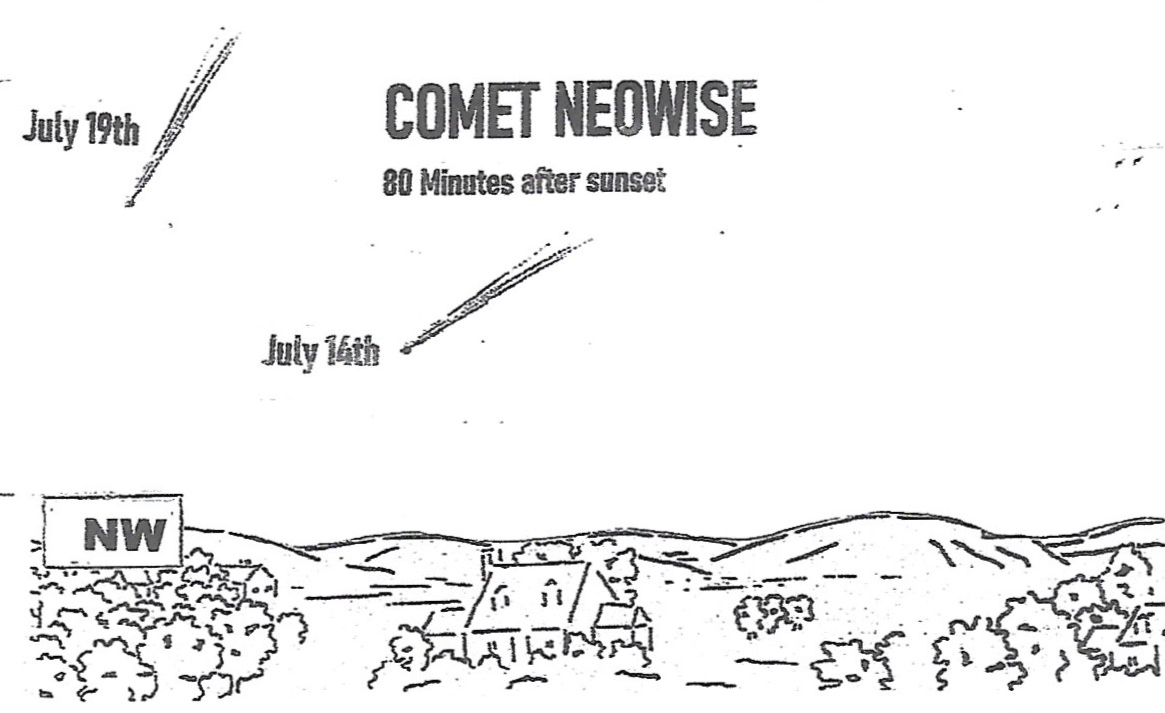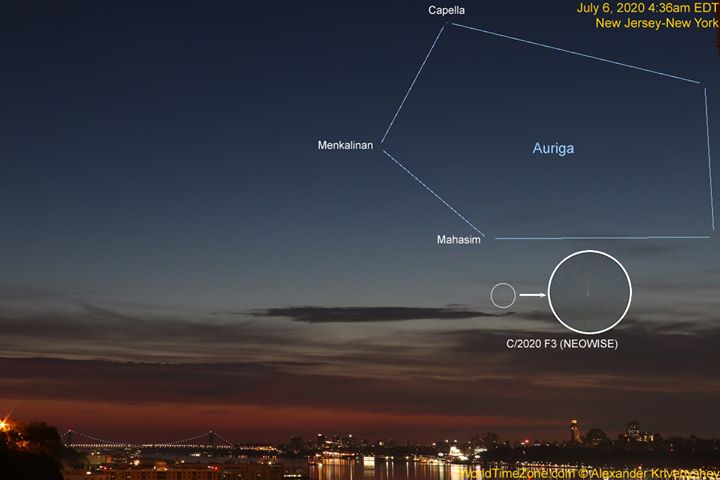How to see Comet NEOWISE in the night sky this month
The early reviews are in: Comet NEOWISE is a hit!
Those who have gotten up before sunrise to gaze into the twilight skies have been greeted by the best comet performance for Northern Hemisphere observers since the 1997 appearance of Comet Hale-Bopp. Indeed, NEOWISE (catalogued C/2020 F3), emphatically ended the nearly quarter-century lack of spectacular comets.
Early fears of another fizzler like comets ATLAS and SWAN quickly eased during June when NEOWISE proved to be an intrinsically bright comet with a highly condensed core. It brightened 100-fold from June 9, when as a seventh-magnitude object it disappeared into the glare of the sun, to June 27, when it appeared in the field of view of the LASCO-3 camera on NASA's Solar and Heliospheric Observatory shining at second-magnitude.
Even before Comet NEOWISE arrived at perihelion — its closest point to the sun — observers could glimpse it very low to the northeast horizon, immersed deep in bright twilight, just before sunrise on July 1.
More: Amazing photos of Comet NEOWISE from the Earth and space
Related: The 9 most brilliant comets ever seen
The comet arrived at perihelion on July 3, sweeping to within 27.7 million miles (44.5 million km) of the sun and is now heading back out to the outer reaches of space. Nonetheless, the comet continues to evolve and its tail continues to grow.
Until now, the comet has been accessible only to those waking up at the break of dawn and scanning the sky near the northeast horizon. The comet has appeared to rise tail-first, followed by its bright head or coma, shining as bright as a first-magnitude star. So far, the comet has had to compete with low altitude, bright twilight and the light of a nearly-full moon. Some have been stymied from getting a good look at NEOWISE because of these factors, or perhaps because of poor weather. But things are going to be getting better for skywatchers in the days ahead.
Breaking space news, the latest updates on rocket launches, skywatching events and more!
As veteran comet observer Terry Lovejoy commented to Space.com: "The best is yet to come!"
How bright?
Although the comet is moving away from the sun and beginning to fade, that dimming initially will likely be slow, because it is now approaching the Earth. It will be closest to our planet on the evening of July 22 ("perigee"), when it will be 64.3 million miles (103.5 million km) away. Thereafter, fading will be more rapid as the comet will then be receding from both the Earth and the sun.
The brightness of a sky object is based on magnitude. Bright stars are ranked "first magnitude." The star Deneb in the Summer Triangle falls into this ranking. The fairly bright stars are of second magnitude. Polaris, the North Star, is a second-magnitude star. A star of third magnitude is considered of medium brightness. Megrez, the star that joins the handle and bowl of the Big Dipper falls into this category.
Based on a special power-law brightness formula, astronomer Daniel Green at the Harvard Smithsonian Center for Astrophysics has forecast how bright NEOWISE should appear in the coming days ahead. His forecast places the comet at first magnitude from now through July 11; second magnitude from July 12 through July 17 and third magnitude from July 18 through July 22.
When and where to look in the morning
As a morning object, the comet's best views will come during a three-day stretch on the mornings of July 11, 12 and 13, when it will stand 10 degrees above the northeast horizon, 80 minutes before sunrise — the beginning of nautical twilight. Your clenched fist held at arm's length measures approximately 10 degrees in width. So, on these three mornings, the head of Comet NEOWISE will appear about "one fist" up from the northeast horizon.
The sky should appear reasonably dark at that time with only the light of the last quarter moon providing any interference. As the minutes tick off, the comet will be getting higher, but the dawn sky will be getting increasingly brighter as well.
Related: Moon phases
After July 13, NEOWISE will drop rapidly lower and swing more toward the north-northeast. By July 18, it will appear only 5 degrees above the horizon at the start of nautical twilight. And only a few mornings later its altitude will have become too low to see it at all in pre-sunrise sky.
Evening visibility
But as its morning visibility diminishes, there is good news: Comet NEOWISE will become prominent in the evening sky after sunset. That will also mean a much larger audience will be able to see it during "prime-time" viewing hours instead of having to awaken during the wee hours of the early morning.

The first good opportunity for evening viewing begins on July 12, when the head of the comet will stand 5 degrees above the north-northwest horizon, 80 minutes after sunset (the end of nautical twilight). By July 14 its altitude will have already doubled to 10 degrees, and by July 19 it will have doubled yet again to 20 degrees up by the end of nautical twilight. By then it will have moved to above the northwest horizon.
So, we at Space.com feel that the best time to view the comet during the evening will come during the July 14-19 time frame.
We also strongly recommend that observers should seek the most favorable conditions possible. Even a bright comet, like this one, can be obliterated by thin horizon clouds, haze, humid air, smoke, twilight glow and especially city lights. We especially emphasize that last factor: the farther away you get from a metropolitan area, the darker your sky and the better your view of NEOWISE. Binoculars will enhance your view.
And more good news: No moonlight will brighten the sky, as the moon will be a waning crescent and visible only in the morning sky through July 20. On successive July evenings the comet will grow fainter, but it will be farther from the sun, setting later and visible in a darker sky. As we move into August, the comet will be very well placed for observers with small telescopes.
Related: Dazzling Comet NEOWISE spotted by NASA sun-studying probe
Oh, that tail!
As for the comet's tail, so far it has displayed a beautiful, gently curved tail of dust which many observers using binoculars and small telescopes have remarked has shown a noticeable yellowish tinge. A much fainter ion (gas) tail accompanies the dust tail. So far the dust tail measures about 4 or 5 degrees in length, but it continues to slowly lengthen and should get more easily seen as viewed against a darker sky and as the comet draws closer to the Earth.
In a comet-watching forum, Minnesota amateur astronomer Bob King wrote: "Comet NEOWISE was astonishingly beautiful this morning (July 7) with a strongly bifurcated (split) tail. Forgive my ignorance, but what causes the bifurcation?" Comet expert John Bortle of Stormville, NY provides us with the answer:
"The dark vacancy that appears to originate just behind the comet's head and extends up the middle of the dust tail is a fairly rare cometary feature generally referred to by 19th century astronomers as, 'the shadow of the nucleus.' Of course, it is not truly a shadow at all, but rather a vacancy in the center of the dust tail, a region largely devoid of cometary dust," Bortle told Space.com in an email.
"In a sense, one can imagine the tail is like a thick-walled hollow tube with its walls impregnated with reflective dust that is being illuminated by sunlight. Would-be observers of the comet should try to spot this rare feature soon, as it is unlikely to be visible once the comet starts fading significantly," Bortle added.
What more can we say? It isn't often we get a sight like this. "COMET get it!"
Joe Rao serves as an instructor and guest lecturer at New York's Hayden Planetarium. He writes about astronomy for Natural History magazine, the Farmers' Almanac and other publications. Follow us on Twitter @Spacedotcom and on Facebook.

Joe Rao is Space.com's skywatching columnist, as well as a veteran meteorologist and eclipse chaser who also serves as an instructor and guest lecturer at New York's Hayden Planetarium. He writes about astronomy for Natural History magazine, Sky & Telescope and other publications. Joe is an 8-time Emmy-nominated meteorologist who served the Putnam Valley region of New York for over 21 years. You can find him on Twitter and YouTube tracking lunar and solar eclipses, meteor showers and more. To find out Joe's latest project, visit him on Twitter.



